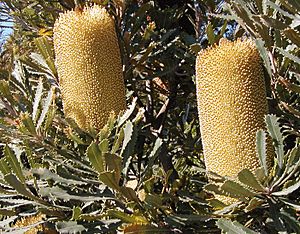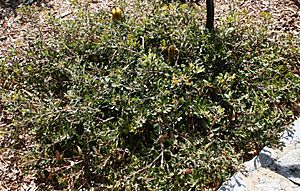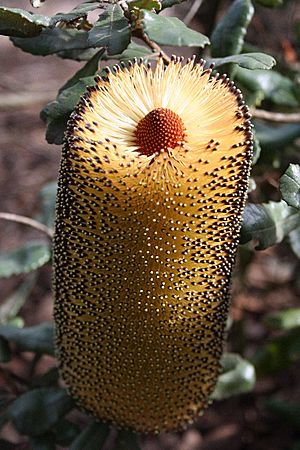Southern plains banksia facts for kids
Quick facts for kids Southern plains banksia |
|
|---|---|
 |
|
| Inflorescences of Banksia media at the Keilor Botanic Gardens. | |
| Scientific classification | |
| Kingdom: | |
| (unranked): | |
| (unranked): | |
| Order: | |
| Family: | |
| Genus: | |
| Species: |
B. media
|
| Binomial name | |
| Banksia media |
|
| Synonyms | |
|
Sirmuellera media (R.Br.) Kuntze |
|
The Banksia media, also called the southern plains banksia or golden stalk banksia, is a type of flowering plant. It belongs to the family Proteaceae. This plant is an evergreen shrub, meaning it keeps its leaves all year round. You can find it growing along the south coast of Western Australia. It is common between Albany and Israelite Bay.
This plant is a bushy shrub with many branches. It has special wedge-shaped leaves with jagged edges. Its flowers grow in large, golden-yellow spikes, which are called inflorescences. The southern plains banksia can grow quite tall, sometimes reaching up to 10 metres (30 ft) high.
When there's a bushfire, these plants usually die. However, they can grow back from their seeds. The flowers are very attractive to birds and insects that feed on nectar and other small bugs. Honeyeaters are especially fond of them. If you want to grow Banksia media, it does best in a sunny spot with soil that drains well. It prefers places with dry summers. This plant is also tougher than many other Western Australian banksias when grown in areas with humid summers.
Contents
What Does the Southern Plains Banksia Look Like?
The Banksia media usually grows as a shrub with many stems. It often reaches about 4 metres (13 ft) tall. Some plants have been recorded growing as tall as 10 metres (30 ft) and as wide as 6 metres (20 ft). The main stem, or trunk, can be up to 30 cm (12 in) thick.
Interestingly, some plants found along the coast, like at Point Ann, grow low to the ground. Their flower spikes stand tall above the leaves. Unlike many other banksias, this plant does not have a special woody swelling at its base called a lignotuber. This means it cannot regrow from its base after a fire.
The plant has grey, cracked bark and hairy stems. New growth appears in the summer. Its dark green leaves are arranged alternately along the stems. They are wedge-shaped and have jagged edges. Each leaf is typically 4 to 12 cm (1.8–4.2 in) long and 0.7 to 2 cm (0.3–0.8 in) wide. The size of the leaves can change depending on where the plant grows. Plants from western and coastal areas have shorter, wider leaves. Inland plants have longer, narrower leaves.
When Does it Flower?
The southern plains banksia mainly flowers from March to August. Sometimes, you might see flower spikes appearing until December. The flowers grow in cylindrical spikes at the ends of short branches. These spikes are usually 6 to 16 cm tall and 7 to 8 cm wide when they are fully open. One group of plants at Mt Ridley has spikes that can reach an impressive 26 cm tall!
Each spike is a complex structure called an inflorescence. It has many individual flowers growing from a central woody stem.
How Scientists Classify the Southern Plains Banksia
Robert Brown, a famous botanist, first described Banksia media in 1830. He found a sample of the plant collected by William Baxter in 1824.
Scientists classify plants into groups to understand how they are related. This helps us learn more about them. For example, in 1870, George Bentham made a detailed list of Banksia species. He grouped them based on features like their leaves and flower parts. He placed Banksia media in a group called section Cyrtostylis.
Later, in 1891, a German botanist named Otto Kuntze suggested changing the name Banksia. He thought the name had been used before for a different plant. He proposed a new name, Sirmuellera media, for Banksia media. However, his challenge was not successful, and the name Banksia was kept.
Where it Fits in the Banksia Family Tree
Scientists continue to study how different Banksia species are related. They use features like flower spikes and even DNA to figure this out. Banksia media is considered to be closely related to other species like B. praemorsa (cut-leaf banksia) and B. epica. These studies help us understand the plant's family tree.
Where the Southern Plains Banksia Grows
The Banksia media is found across southern Western Australia. Its range stretches from the eastern edge of Stirling Range National Park all the way to Israelite Bay. It also extends northwards to places like Pingrup and Frank Hann National Park. There's even a separate group of these plants further east along the coast at Point Culver and Toolinna.
This plant is often found in large numbers in its local areas. It can grow in many different types of soil. Most commonly, it's found in white sand or sandy loam. But it can also grow in red clay, loam over limestone, shale, or soil with granite. You'll typically find it in heathland, shrubland, or open woodland areas.
Life Cycle and Ecology
The Banksia media is a plant that dies during a bushfire. However, it has a clever way to survive: it grows back from its seeds. In places like Fitzgerald River National Park, it takes about ten years for new plants to flower and produce seeds after they sprout. Fires in this area usually happen every 30 to 60 years, giving the plants enough time to regrow and make new seeds.
The bright and colourful flower spikes of Banksia media are very attractive to animals that help spread pollen. Many different creatures visit them. These include honey possums and several types of honeyeater birds, such as the New Holland honeyeater, white-cheeked honeyeater, red wattlebird, and western spinebill. Insects like the meat ant and European honeybee also visit the flowers. Studies have shown that these spikes can even produce seeds without pollinators, meaning they can sometimes pollinate themselves.
Growing Southern Plains Banksia
The Banksia media is quite strong against a plant disease called dieback. This disease is caused by a tiny water mould called Phytophthora cinnamomi. Many other Western Australian banksias are much more sensitive to this disease.
If you want to grow Banksia media from seeds, you don't need to do anything special to them. The seeds usually sprout within 20 to 46 days.
See also
 In Spanish: Banksia de las llanuras del sur para niños
In Spanish: Banksia de las llanuras del sur para niños



